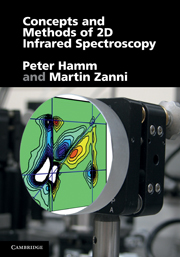Book contents
- Frontmatter
- Contents
- 1 Introduction
- 2 Designing multiple pulse experiments
- 3 Mukamelian or perturbative expansion of the density matrix
- 4 Basics of 2D IR spectroscopy
- 5 Polarization control
- 6 Molecular couplings
- 7 2D IR lineshapes
- 8 Dynamic cross-peaks
- 9 Experimental designs, data collection and processing
- 10 Simple simulation strategies
- 11 Pulse sequence design: Some examples
- Appendix A Fourier transformation
- Appendix B The ladder operator formalism
- Appendix C Units and physical constants
- Appendix D Legendre polynomials and spherical harmonics
- Appendix E Recommended reading
- References
- Index
8 - Dynamic cross-peaks
Published online by Cambridge University Press: 05 August 2012
- Frontmatter
- Contents
- 1 Introduction
- 2 Designing multiple pulse experiments
- 3 Mukamelian or perturbative expansion of the density matrix
- 4 Basics of 2D IR spectroscopy
- 5 Polarization control
- 6 Molecular couplings
- 7 2D IR lineshapes
- 8 Dynamic cross-peaks
- 9 Experimental designs, data collection and processing
- 10 Simple simulation strategies
- 11 Pulse sequence design: Some examples
- Appendix A Fourier transformation
- Appendix B The ladder operator formalism
- Appendix C Units and physical constants
- Appendix D Legendre polynomials and spherical harmonics
- Appendix E Recommended reading
- References
- Index
Summary
In Chapter 7 we found that a time dependent Hamiltonian (Eq. 7.2) is the source of infrared lineshapes. It also causes energy transfer between eigenstates that will alter the intensity of cross- and diagonal peaks or create completely new peaks. As for lineshapes, the time dependence of the Hamiltonian results from the fluctuations of the solvent and molecular structure. Three types of relaxation occur, all of which have been observed experimentally: population relaxation, population transfer, and coherence transfer. Figure 8.1 shows an example of a Feynman diagram for each of these cases. In contrast to the Feynman diagrams that we have seen so far, these diagrams time-propagate with more than just the usual oscillatory terms. They flip quantum states (indicated by the dotted lines and the arrows in Fig. 8.1). Population relaxation, population transfer, and coherence transfer correspond to flipping an excited population state |1〈〉1| back into the ground state |0〈〉0| (Fig. 8.1a), flipping an excited population state |1〈〉1| into another excited state |1'〈〉1'| (Fig. 8.1b), and flipping a coherence state |0〈〉1| into another coherence state |0〈〉1'| (Fig. 8.1c), respectively. A rigorous treatment of relaxation processes has become quite demanding, and we outline here only the simplest cases. For a more comprehensive discussion, we refer readers to Ref. [106].
Population transfer
As the simplest case, consider a dimer of coupled oscillators that is sitting in a fluctuating bath.
Information
- Type
- Chapter
- Information
- Concepts and Methods of 2D Infrared Spectroscopy , pp. 166 - 175Publisher: Cambridge University PressPrint publication year: 2011
